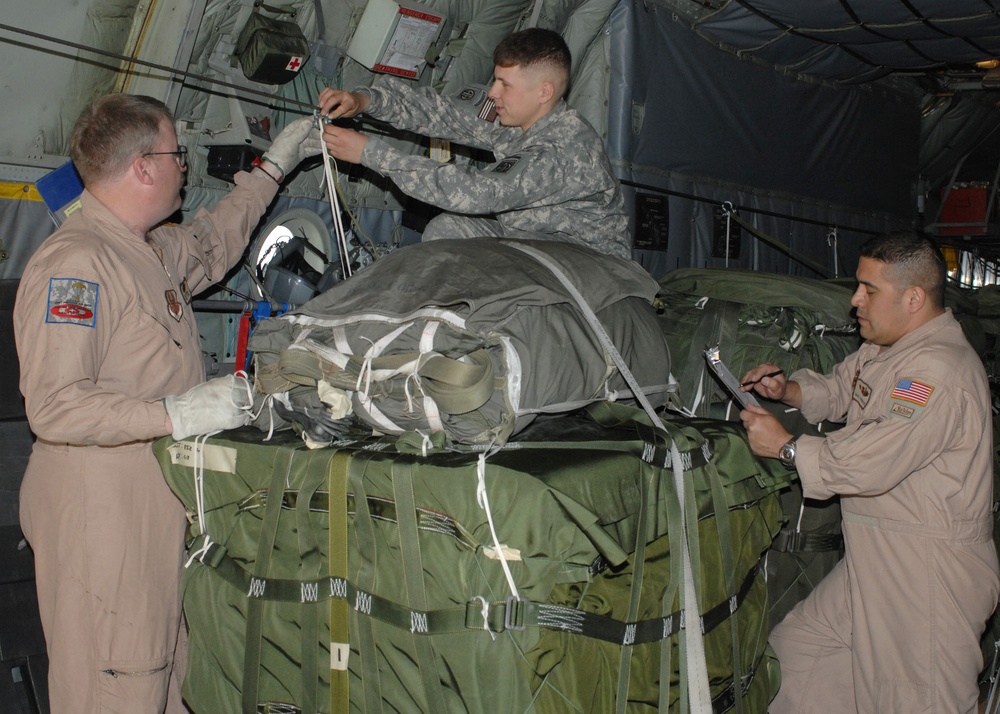Air Force and Army Set New Airdrop Record in Afghanistan Operations

Air Force and Army Collaborate to Achieve Record airdrop in Afghanistan
Joint Efforts Lead to Significant Supply Deliveries
In a remarkable display of teamwork, the Air Force’s 74th Air Expeditionary Squadron, supported by the Army’s 11th Quartermaster Rigger Detachment and Combined Joint Special Operations Task Force, set a new record for airdrops last month.
- Joint Efforts Lead to Significant Supply Deliveries
- Record-Breaking Deliveries Amid Harsh Conditions
- Advantages of C-130 Aircraft Over Helicopters
- Aerial Delivery Methods in Operation Enduring Freedom
- High Volume of Supplies Rigged Daily
- Humanitarian Aid Amidst Severe Winter Conditions
- Preparedness for Emergencies
- Quality Control and Collaboration
Record-Breaking Deliveries Amid Harsh Conditions
During February, this collaborative effort resulted in the delivery of approximately 1 million pounds of essential supplies to both deployed military personnel and Afghan communities in need. This achievement marks a 40% increase compared to operations in January and surpasses the previous record established in September.
Air Force Lt. Col. Scott Morris, who previously served as the director of operations for the 774th EAS, noted that the severe winter weather and impassable roads necessitated an increase in airdrop missions. “Airdrops were the most effective way to ensure that vital supplies reached both the troops and local villagers,” he stated.
Advantages of C-130 Aircraft Over Helicopters
The C-130 Hercules transports utilized by the squadron provide distinct advantages over rotary-wing aircraft, according to Army Chief Warrant Officer Joe DeCosta, an airdrop system technician and detachment commander. He explained that while helicopters can deliver supplies, they cannot match the volume or safety of higher-flying cargo planes.
Aerial Delivery Methods in Operation Enduring Freedom
DeCosta elaborated on the two primary aerial delivery methods employed in Operation Enduring Freedom: low-cost, low-altitude delivery (LCLA) using Casa 212s, and container delivery system (CDS) airdrops utilizing Air Force C-130s and C-17s. He emphasized that while LCLA is effective for smaller groups, it cannot compete with the capacity of CDS.
The CDS system, which the Army uses for assembling and rigging supply bundles, incorporates parachutes, plywood skid boards, and energy-dissipating materials. These bundles can weigh between 500 and 2,200 pounds.
High Volume of Supplies Rigged Daily
The 21-member detachment is capable of rigging up to 50 CDS bundles daily, equating to over 100,000 pounds of supplies for a 12-day operational period. DeCosta mentioned that they could potentially double this output if necessary. In February alone, the detachment prepared more than 480 CDS bundles, totaling around 650,000 pounds for coalition forces across Afghanistan.
Humanitarian Aid Amidst Severe Winter Conditions
Notably, nearly 35% of the cargo delivered in February was humanitarian assistance, including blankets, rice, beans, coal, oil, and stoves for Afghan villagers suffering from extreme winter conditions. Reports indicate that over 300 individuals lost their lives due to the harsh weather.
The remaining 600,000 pounds of supplies were directed to coalition troops stationed at forward operating bases, who are engaged in efforts to combat insurgency and promote stability in the region.
Preparedness for Emergencies
DeCosta highlighted that the team maintains around 150 contingency bundles ready at all times to respond to any urgent humanitarian needs. In addition to standard supplies, the riggers strive to accommodate requests from units, having prepared bundles containing Gatorade, ice cream, fruits, vegetables, and even frozen meals served in dining facilities.
Quality Control and Collaboration
Before transport, riggers conduct thorough quality checks on the bundles and stage them for loading onto aircraft the night before. Once loaded, the loadmaster and a joint airdrop inspector perform additional inspections to ensure everything is secure and ready for deployment.
Air Force Master Sgt. Mike Pierson, a joint airdrop inspector with the 774th EAS and a member of the Delaware Air National Guard’s 142nd Airlift Squadron, emphasized the importance of collaboration between the Army and Air Force in these operations. “Working together in a combat environment is where our efforts truly pay off,” he remarked.
This article was prepared by Capt. Toni Tones, serving with the 455th Air Expeditionary Wing Public Affairs.







